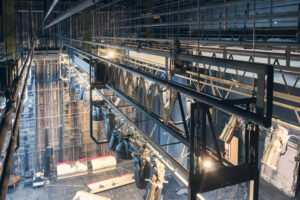
Rigging systems can present hazards during performances. Establishing and adhering to safety routines reduces the risk of injury to staff, performers and audience members.
Keep Backstage Space Organized
Theatre rigging equipment is less likely to cause an injury when items are organized and stored properly. It’s a good habit to clean and organize components as soon as you’re done working. That can boost efficiency since you don’t have to complete last-minute decluttering.
A neat performance space also supports crew, performer and audience safety as loose ropes and unsecured equipment present tripping hazards. You should also secure all items attached to the rigging grid, catwalks and gallery to prevent objects from falling.
Here are some tips for keeping your performance space organized:
- Label racks, bins and shelves to easily identify equipment.
- Use clips to keep cables and ropes neatly coiled.
- Ensure walkways and emergency exits are clear of clutter.
- Implement a check-in/check-out system to keep track of tools and rigging components.
Perform Quarterly Rigging Inspections
Rigging systems must undergo comprehensive inspections to ensure components function properly. Scheduling regular safety inspections allows you to identify early signs of wear that could cause malfunctions. Addressing those warning signs proactively can reduce the risk of injury or fatality.
Inspection results allow you to identify opportunities to conduct regular maintenance. Doing so can protect your bottom line and prevent costly repairs and equipment replacement. Inspections are also required by the American National Standards Institute, so completing them will keep your facility in compliance with their standards.
Participate in Safety Training
Educate your staff on handling rigging equipment correctly to promote safety on the job. Scheduling regular training sessions ensures your team is aware of changes and upgrades, too.
Teaching risk awareness helps crew members recognize potentially dangerous working conditions. That knowledge can help them take appropriate precautions and reduce their risk of injury.
Here are some tips to remember:
- Evaluate your crew’s safety skills and proficiency.
- Schedule training sessions at regular intervals.
- Maintain an updated training log and records of each session.
- Plan for safety briefings before and after performances or shows.
Invest in Fall Protection
The elevated nature of theatre and stage rigging equipment can put your crew at risk of falling. Any working environment above six feet without railings requires fall prevention equipment. It’s also crucial to have a safety plan in place for emergencies.
A fall protection plan includes:
- Identifying potential hazards
- Training staff on fall safety best practices
- Inspecting and using fall prevention equipment
- Creating a rescue plan
Assessing and addressing fall risks enhances crew and performer safety and provides peace of mind. Preventing accidents and injury also reduces the likelihood of legal complications and penalties.
Get your staff involved with risk assessment and mitigation so they learn to spot hazards and provide necessary feedback. Crew members should also work in pairs to verify equipment integrity and provide assistance.
Custom Theatre Rigging from Tiffin Scenic Studios
We specialize in manual and motorized rigging solutions. Contact our expert team to learn about our design, installation and inspection services.